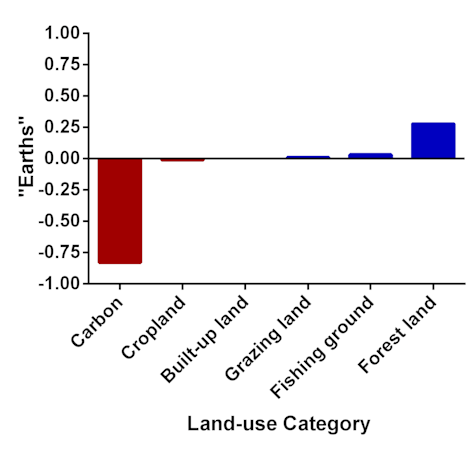Correction, Coercion, or Collapse
The Flawed Science Behind the Modern Population Control Movement

-
-
Share
-
Share via Twitter -
Share via Facebook -
Share via Email
-
Drastic prophecies beget drastic solutions. In a recent paper, the ecologist William Rees writes that due to pollution, climate change, and overexploitation of natural resources, “the global economy will inevitably contract and humanity will suffer a major population ‘correction’ in this century.”
Rees may not be a household name even among environmentalists, but anyone who has heard of the concept of an “environmental footprint” is familiar with his work. In the 1990s, Rees and his colleague Mathis Wackernagel introduced the concept of the “Ecological Footprint,” a metric purported to synthesize a number of human influences on the environment.
So it’s worth understanding the faulty science behind Rees’s apocalyptic predictions, and the ways in which limits-based ecological thinking has animated coercive population control campaigns and much else in the broader environmentalist project.
It is not just that environmental scientists like Rees have produced one failed forecast after another for decades, always wrapped in a sheen of scientific precision and authority but ultimately committed to the same underlying vision of scarcity. Or that the new population control movement claims to be a kinder, gentler version of the old population control movement, simply advocating for girls education and other seemingly unobjectionable measures. It is that the combination of neo-Malthusian claims about the environmental limits on human populations with advocacy for population control measures almost always devolves into coercive measures, irrespective of the happy face that proponents have always put on their plans.
That is what makes Rees’s use of the term “correction” so chilling. Whether undertaken by environmental technocrats or “Nature,” the clear implication is that population control is coming, whether those whose fertility is going to be controlled like it or not.
Ecological footprints—and their overshoot
Today, the Ecological Footprint is probably best associated with Earth Overshoot Day, the annual anti-holiday that “measures how much nature we have and how much nature we use.”
“It's #OvershootDay, the day humanity has used up all the natural resources the Earth can produce within a year.”
So tweeted Population Matters, a population control advocacy group, on August 2 of this year. The calculation is elemental to Population Matters’ mission of “ending and reversing population growth as soon as possible, and dramatically changing the way we live in overconsuming wealthy nations.”
That mission may conjure problematic associations with coercive sterilization campaigns and authoritarian one-child policies. But if you’re made nervous by calls for population control, you just need to calm down, according to the Population Matters. “Coercive measures, like China’s one-child policy, are not needed and abuse people’s human rights,” they write on the “Mythbusting” page of their website. Instead, the organization insists “modern population campaigners” focus on solutions like contraceptives, girls’ education, and general “women’s empowerment.”
Population Matters is not the only group working to rebrand the ugly image of population control. Earlier this year, my colleague Vijaya Ramachandran and I wrote an essay in The Atlantic in which we argued that neo-Malthusian population control ideas remain alive and well in the mainstream environmental movement, for instance in climate scientist Michael Mann’s enthusiastic endorsement of Population Bomb author Paul Ehrlich’s legacy, or the historian Naomi Oreskes’ recent op-ed titled “Eight Billion People in the World Is a Crisis, Not an Achievement.”
Not unlike Population Matters’ mythbusting, Mann and Oreskes have protested a bit too much. In a response to our essay, they insisted “we do not need coercive practices” to address “the pressure of population.” Mann and Oreskes, like most environmentalists, argue that a significantly reduced human population, combined with a wholesale shift towards renewable energy technologies, can keep human societies within the Earth’s carrying capacity.
Rees’s paper, published earlier this month, though, goes a bit further. “Human numbers will fall to the point where survivors can once again hope to thrive within the (much reduced) carrying capacity of the Earth….It may well be that the best-case future will, in fact, be powered by renewable energy, but in the form of human muscle, draft horses, mules, and oxen supplemented by mechanical water-wheels and wind-mills.”
Ecological footprints' fatal flaw
In the 1990s, Rees and Wackernagel invented a metric that purported to synthesize a number of human influences on the environment—including carbon emissions, built-up land, fisheries, grazing land, forestland, and cropland—to produce a single, per-capita measure of environmental impact. Wackernagel went on to found the Global Footprint Network and apply the metric towards its mission “to help end ecological overshoot by making ecological limits central to decision-making.” It is the Global Footprint Network that calculates the day, every year, when humanity has purportedly used a year’s worth of Earth systems resources.
So it is worth remembering that the metric—the Ecological Footprint—is fatally flawed.
The metric weighs production and consumption to determine whether a given resource is in surplus or deficit. But for most of the categories, the accounting is a wash. Humanity consumes almost exactly as many crops as it produces, so cropland, despite being the single largest driver of deforestation and land-use change, is sustainable according to the Ecological Footprint methodology. Indeed, in their measure, the only reason humanity’s aggregate footprint is in deficit at all is its exploitation of fossil fuels. This bizarre accounting leads to some true nonsense: Humans could achieve ecological harmony (and also wipe out what’s left of wild nature) by converting all remaining forests and grasslands into bioenergy plantations to replace fossil fuels.
As the figure below indicates, virtually all of the ecological deficit behind the network’s “overshoot” metric comes from the carbon factor, which itself is determined by calculating how much extra standing forests would be necessary to offset anthropogenic emissions. Instead of measuring carbon emissions, or deforestation, or overfishing, directly, the Ecological Footprint hides the ball, with the effect of presenting a more totalizing and catastrophist metric.
Net biocapacity by land-use category

The network lists solutions like girl’s education, renewable energy, and a reduction in personal vehicle use on its website. But under this fundamentally broken framework, it is little surprise that Rees considers the total collapse of human civilization the only workable “solution.” The Ecological Footprint’s creator dismisses even ideas popular with other environmentalists. “Seduced by the promise of cheap, 100% renewable energy,” he writes in the new paper, “the world has also bought into a new mythic construct, the so-called renewable energy (RE) transition.”
The emptiness of Rees and Wackernagel’s concept has not stopped it from gaining influence. Wackernagel has celebrated how popular the idea of an environmental footprint has become, telling the New York Times in 2008 that the idea got “its biggest boost in 2005 through an enormous BP media campaign on the carbon footprint.” And each year, the Global Footprint Network’s Overshoot Day declaration achieves its desired effect: credulous media coverage, like this year’s TIME Magazine headline “In Just 7 Months, the World Used an Entire Year's Worth of Planetary Resources.”
The widespread receptivity to the Ecological Footprint is evidence of the reach of an environmentalist metaphysics based on purportedly scientific limits, boundaries, carrying capacity, and targets. The Ecological Footprint and its permutations are deeply implicated across modern environmentalism, entangled with the science, philosophy, advocacy, and communications of the broader environmental project. That project imagines Earth as a kind of unitary superorganism with non-negotiable biophysical boundaries, and humans as little more than sentient bacteria whose numbers and activity are the chief threat to the superorganism. As Rees puts it, “The conflict between mass delusion and biophysical reality is increasingly evident in the destabilization of the ecosphere induced by the excessive scale of the human enterprise.”
These are old environmentalist ideas. Throughout his new paper, Rees approvingly quotes Herman Daly, the celebrated “father of ecological economics,” who said that “the human economy is a fully-contained wholly-dependent growing subsystem of the non-growing ecosphere.” That line has been making the rounds lately, including in the latest effort to rebrand climate change, this time as “global boiling.”
Like its similarly confused yet influential conceptual cousin, the Planetary Boundaries framework, the Ecological Footprint can be found at the bottom of much of the limits-based framework active in environmental discourse and advocacy today. In these broken, faux-scientific frameworks, ecological boundaries are fixed and imposing, while technology can, at best, slow humanity’s march towards catastrophe. “Technology can solve many of our problems, but it can't solve all of them,” Oreskes recently told Population Balance, another population control advocacy group that has publicized Earth Overshoot Day, “and especially not when we're talking about planetary limits.”
And it is with these limits, based as they are on accounting gimmicks, that Oreskes, Rees, and like-minded thinkers keep returning to the subject of human population collapse. “Collapse is not a problem to be solved,” Rees writes, “but rather the final stage of a cycle to be endured.” This reads remarkably like the thinking of Paul Ehrlich, who wrote just a few years ago that “collapse of civilisation is a near certainty within decades.” Oreskes actually imagined such a future in her 2014 novel The Collapse of Western Civilization.
How much would the human population need to shrink to avoid this collapse? Consider the words of famed primatologist Jane Goodall, who claimed that she “would like to, without causing any pain or suffering, reduce the number of people on the planet.” Goodall was more specific in a World Economic Forum talk, asserting that “all these things we talk about wouldn’t be a problem if there was the size of population that there was 500 years ago.” This suggests a—surely painless—93% decline in the population of the world today.
Ehrlich, Rees, and others suggest that the right number could be “between 2 and 4 billion people,” according to a 2022 paper, although in his newer paper Rees writes that “informed estimates put the long-term carrying capacity at as few as 100 million.”
This is, arguably, a low and narrow range. A United Nations report surveyed the literature in 2012 and “found estimates ranging from a low of 500,000,000 to a high of 1,000,000,000,000,000,000,000.”
Humans and nature, decoupled
It is true, of course, that humanity’s growth, both in numbers and in resource consumption, has come at nature’s expense. Humans have converted almost half of the ice-free land on the planet toward economic production, extirpating vast animal life in the process. Much of our species’ destructiveness occurred before the Industrial Revolution, but our impact has certainly grown in recent centuries. Industrial pollution and greenhouse gasses cause both localized and global environmental problems, and the growth in our species’ total headcount is part of the reason both problems are larger today.
This does not, however, mean that humans have “adopted a self-terminating way of life” or a “one-off population boom–bust cycle” as Rees describes it. Indeed, human societies have been remaking their environments and adapting to shifting techno-ecological capacities since long before the “modern techno-industrial society” that he decries. As my colleague Ted Nordhaus wrote on the subject in 2018,
In fact, we have been engineering our environments to more productively serve human needs for tens of millennia. We cleared forests for grasslands and agriculture. We selected and bred plants and animals that were more nutritious, fertile and abundant. It took six times as much farmland to feed a single person 9,000 years ago, at the dawn of the Neolithic revolution, than it does today, even as almost all of us eat much richer diets. What the palaeoarcheological record strongly suggests is that carrying capacity is not fixed. It is many orders of magnitude greater than it was when we began our journey on this planet.
And while human progress may have come at the expense of non-human nature, the actual footprint of each person appears to be in decline. A typical human’s diet today uses less land for food production than her ancestors’ did. The carbon intensity of global GDP has been declining steadily for decades. Humans now use about as much total land for crop production and forest timber as we did three decades ago, and there are two and a half billion more of us on the planet today. Forests, whales, condors, and more are coming back, owing partly to conservation policies made possible by societal wealth but also to reduced pressure on ecosystems in an economy increasingly dependent on knowledge and services instead of farming and wildlife harvesting.
In fact, it is precisely the pillars of modern techno-industrial society that have pushed fertility rates downward in recent decades. Public health interventions that have slashed infant mortality, combined with the decreased labor intensity of agriculture, have effectively reduced people’s incentive to reproduce. Prospective parents don’t expect a quarter of their offspring to die, as was common even a century ago, and therefore don’t “overshoot” to achieve their desired family size. At the same time, the need for an extra family member is lower when the family is not dependent on subsistence labor, as nearly all families were 200 years ago but relatively few are today. Finally, with increased wealth and economic options come higher opportunity costs to having children.
Decoupling, in other words, reduces the tradeoff between humans and nature that Rees, Oreskes, Mann, Ehrlich, and Goodall have clumsily tried to account for. Technology and wealth are, to date, associated with lower fertility, not greater. And with sufficient low-carbon energy from nuclear reactors and solar panels, and highly productive grain and protein production concentrated on relatively small areas on the Earth’s surface, there is no reason the world’s population couldn’t grow substantially while using fewer natural resources and leaving more room for nature than exists today.
Catastrophism strikes again
We should keep the population hawks’ fanatical predictions and nonsensical ecological concepts in mind every time advocates invoke notions of static carrying capacity or hard scientific boundaries on human population. And when “modern population campaigners” assure us that, this time, the population control movement will use only non-coercive methods to keep human population within these shoddily-designed limits, we should exercise some skepticism. The scientific justification at the bottom of these campaigns is much more catastrophist than many of their adherents have likely realized.
Fortunately, as Ramachandran and I pointed out in our essay for The Atlantic, there are signs of progress even from within the environmental movement. Last year, the Sierra Club ended all its population control advocacy, including for “family planning as climate mitigation, or promoting women’s empowerment or girls’ education.”
But there remains much work to do to confront the broken metaphysics at the heart of the modern environmentalist project. On August 2 of this year, the United Nations Framework Convention on Climate Change (UNFCCC) posted a tweet in commemoration of Earth Overshoot Day.
